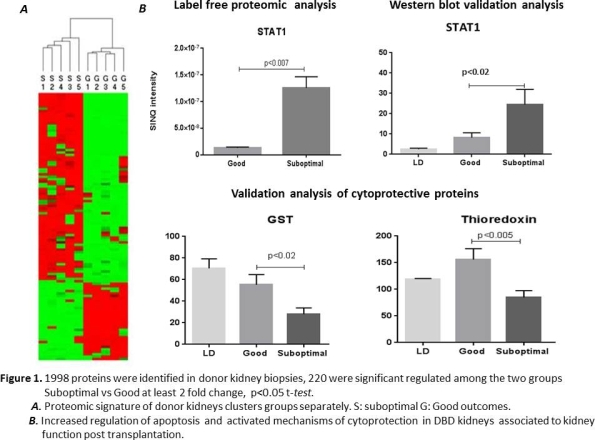Activated Cytoprotective Mechanisms in DBD Kidneys Correlate with Kidney Function in Transplant Recipients: A Study Using Clinical Samples from the UK QUOD Biobank.
1Nuffield Department of Surgical Sciences, University of Oxford, Oxford, United Kingdom
2UMCG, UMCG, Groningen, Netherlands.
Meeting: 2016 American Transplant Congress
Abstract number: 20
Keywords: Apoptosis, Donors, Glomerular filtration rate (GFR), marginal, Renal ischemia
Session Information
Session Name: Concurrent Session: Donor Management: All Organs
Session Type: Concurrent Session
Date: Sunday, June 12, 2016
Session Time: 2:30pm-4:00pm
 Presentation Time: 2:30pm-2:42pm
Presentation Time: 2:30pm-2:42pm
Location: Room 306
The onset of abnormal pathophysiological changes following brain death adversely impact kidney function following transplantation. Understanding the biological mechanisms that affect kidney quality will allow better allocation of donated kidneys, minimising discard and promoting the development of novel interventions that will improve allograft outcomes.
Methods
Kidney biopsies obtained at kidney retrieval from 40 DBD donors were matched for donor and recipient age, cold ischemic time and grouped according to kidney function following transplantation. The combination of delayed graft function in the recipient and a median eGFR of 28ml/min (range 16 to 39 ml/min) at 3 month post transplantation was defined as suboptimal kidney function while immediate function and median eGFR of 64ml/min (range 50 to79 ml/min) at 3 months follow up as good function. Using label free quantitative proteomics we compared individual samples from the two groups. Validation by immunoblotting in a separate cohort was performed. Living donor Kidney biopsies analysed as control group.
Results
Without “a priori” assumptions and based on donor kidney proteomic signatures we could differentiate the donors with kidneys that developed suboptimal function after transplantation. An increased regulation of the apoptosis transcription factor STAT-1 was found in addition to enhanced degradation of cytoskeletal and extracellular matrix integrin proteins of kidneys with suboptimal function. This indicated the onset of acute kidney injury in donor kidneys. An increased abundance of antioxidant proteins such as thioredoxin and peroxiredoxins in good outcome-associated kidneys suggested the parallel activation of repair mechanisms
Discussion
The identified proteomic signature of donor kidneys can discriminate kidneys with suboptimal function from those with good function in the recipient. Kidney quality depends on the balance of ischemia and repair. Interventions during donor management and organ preservation should aim to enhance repair mechanisms.
CITATION INFORMATION: Kaisar M, van Dullemen L, Akhtar Z, Lo Faro M, Huang H, Leuvenink H, Kessler B, Ploeg R. Activated Cytoprotective Mechanisms in DBD Kidneys Correlate with Kidney Function in Transplant Recipients: A Study Using Clinical Samples from the UK QUOD Biobank. Am J Transplant. 2016;16 (suppl 3).
To cite this abstract in AMA style:
Kaisar M, Dullemen Lvan, Akhtar Z, Faro MLo, Huang H, Leuvenink H, Kessler B, Ploeg R. Activated Cytoprotective Mechanisms in DBD Kidneys Correlate with Kidney Function in Transplant Recipients: A Study Using Clinical Samples from the UK QUOD Biobank. [abstract]. Am J Transplant. 2016; 16 (suppl 3). https://atcmeetingabstracts.com/abstract/activated-cytoprotective-mechanisms-in-dbd-kidneys-correlate-with-kidney-function-in-transplant-recipients-a-study-using-clinical-samples-from-the-uk-quod-biobank/. Accessed December 20, 2025.« Back to 2016 American Transplant Congress
